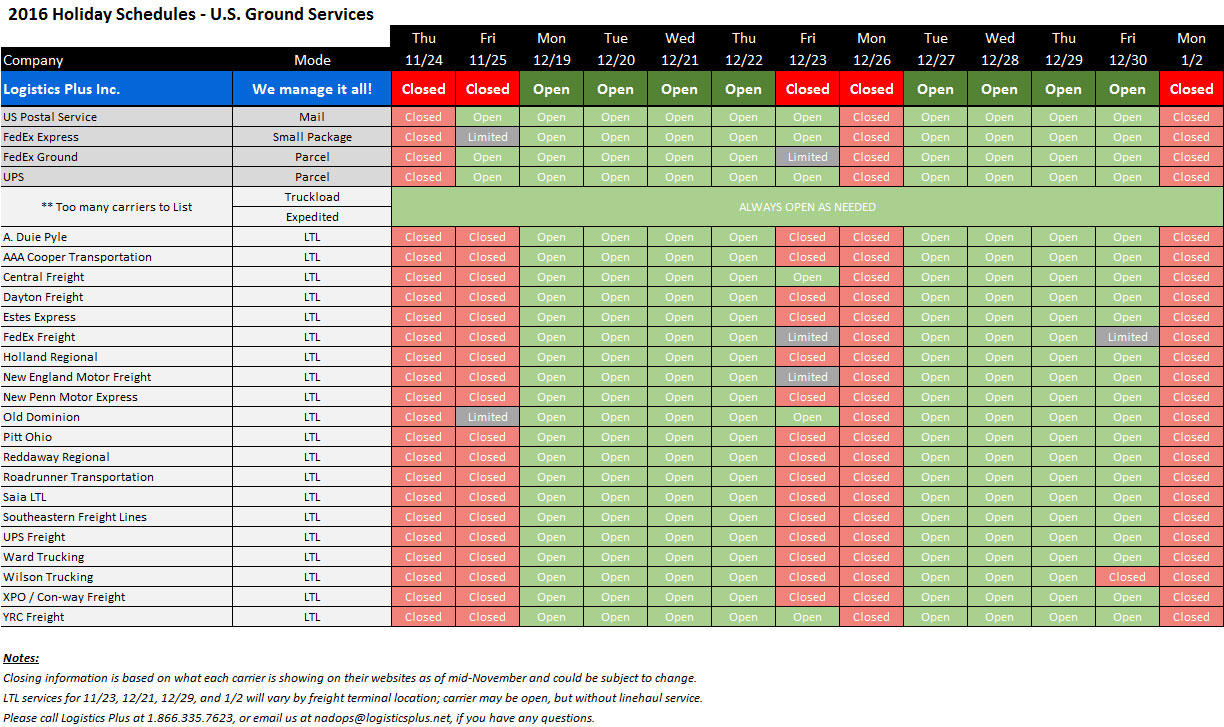
by logisticsplus | Nov 17, 2016 | News
U.S. Holiday schedules for Logistics Plus and ground carriers
As the holidays approach, we want to help you avoid any unnecessary shipping delays over the next few weeks. Shown below is the holiday schedule for U.S.-based Logistics Plus offices and warehouse locations, as well as the top U.S. ground (parcel and LTL) carriers. If you have any special transportation needs, or expedited shipping requests, please contact Logistics Plus in advance of the office closings noted below. You can use the Logistics Plus online global directory to find any of our people or our locations. You can also reach our North American freight division by calling 1.866.335.7623 or emailing us at nadops@logisticsplus.com.

Click image to see a slightly larger version of table.

by logisticsplus | Nov 16, 2016 | News
Wondering whether your domestic freight shipment should move via parcel, less-than-truckload (LTL), or full-truckload (FTL) carrier? Here’s a quick cheat-sheet with some PROs and CONs to each of these ground transportation modes.
 Parcel Shipping: Shipments under 150 pounds and shipped in cartons (less than 108 inches long and 67 inches wide), rather than on a pallet, are often moved via Parcel shipping with carriers such as USPS, UPS, FedEx or regional courier services.
Parcel Shipping: Shipments under 150 pounds and shipped in cartons (less than 108 inches long and 67 inches wide), rather than on a pallet, are often moved via Parcel shipping with carriers such as USPS, UPS, FedEx or regional courier services.
- PROS: Fast service, many delivery options, readily available, lower shipping costs on smaller shipments.
- CONS: More chance of being lost or damaged, lower carrier liability limits per pound, few carrier options.
 Standard Less-Than-Truckload (LTL) Shipping: Shipments between 150 and 5,000 pounds are generally better moved using standard LTL carrier pricing with LTL carriers such as FedEx Freight, UPS Freight, YRC Freight, or regional freight carriers.
Standard Less-Than-Truckload (LTL) Shipping: Shipments between 150 and 5,000 pounds are generally better moved using standard LTL carrier pricing with LTL carriers such as FedEx Freight, UPS Freight, YRC Freight, or regional freight carriers.
- PROS: Relatively fast service, good availability, fewer damages, good with B2B deliveries, higher carrier liability limits pound.
- CONS: Complex pricing structure, higher shipping costs, not always suitable for non-palletized freight, not always great with B2C deliveries, minimal carrier options.
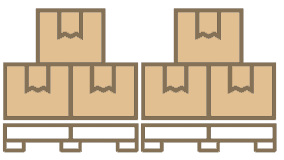 Volume Less-Than-Truckload (LTL) Shipping: Shipments between 5,000 and 10,000 pounds, or taking up more than 6 pallet spaces, are often moved more cost-effectively with a “volume” or “spot” quote. In these situations, the carrier will analyze the weight and dimensions of the shipment and provide a competitive “all-in” rate quote.
Volume Less-Than-Truckload (LTL) Shipping: Shipments between 5,000 and 10,000 pounds, or taking up more than 6 pallet spaces, are often moved more cost-effectively with a “volume” or “spot” quote. In these situations, the carrier will analyze the weight and dimensions of the shipment and provide a competitive “all-in” rate quote.
- PROS: All of the above, plus this approach will generally produce a lower price than standard LTL shipping rates.
- CONS: Often predicated on when or where LTL carrier has equipment available and need for more freight volume, getting quotes takes more time.
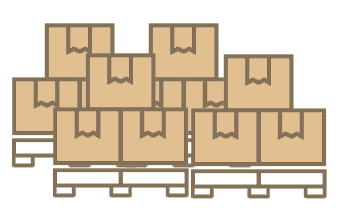 Partial Truckload Shipping: Shipments between 10,000 and 20,000 pounds, or taking up more than 10 pallet spaces, are often moved more cost-effectively as a partial truckload. In these situations, the truckload carrier will analyze the weight and dimensions of the shipment and provide a competitive “all-in” rate quote.
Partial Truckload Shipping: Shipments between 10,000 and 20,000 pounds, or taking up more than 10 pallet spaces, are often moved more cost-effectively as a partial truckload. In these situations, the truckload carrier will analyze the weight and dimensions of the shipment and provide a competitive “all-in” rate quote.
- PROS: Generally produces a lower pricing than standard or volume LTL shipping rates, since shipment only takes up part of the trailer, carrier can sell remaining capacity to another customer to share the costs, many more carrier options.
- CONS: Finding right carrier with capacity is often difficult, predicated on when or where carrier has equipment available, getting quotes takes more time, must vet carrier to ensure safe and reliable.
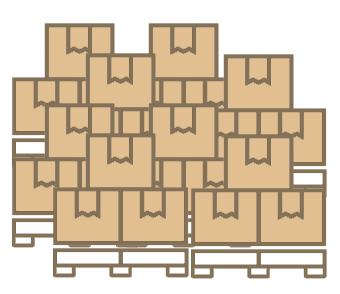 Full Truckload (FTL) Shipping: Shipments over 20,000 pounds are often moved more cost-effectively as a full truckload. In these situations, the carrier will analyze the weight and dimensions of the shipment and provide a competitive “all-in” rate quote.
Full Truckload (FTL) Shipping: Shipments over 20,000 pounds are often moved more cost-effectively as a full truckload. In these situations, the carrier will analyze the weight and dimensions of the shipment and provide a competitive “all-in” rate quote.
- PROS: Generally the most cost-effective way to ship per pound, less susceptible to damages because freight is normally moved door-to-door on one trailer (no re-handlings), many more carrier options.
- CONS: Finding right carrier with capacity is often difficult, predicated on when or where carrier has equipment available, getting quotes take more time, must vet carrier to ensure safe and reliable.
Need help deciding how best to ship your freight the most using the most cost-effective ground transportation mode? Let Logistics Plus help you with a risk-free freight analysis or freight quote.


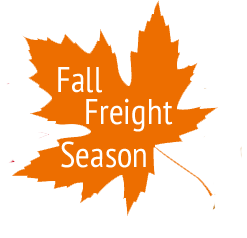
by logisticsplus | Oct 18, 2016 | News
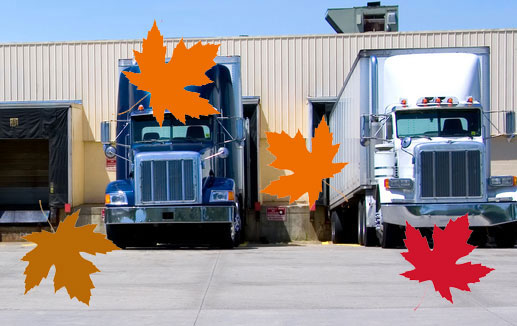 The leaves are turning, temperatures are dropping, and the peak Fall freight shipping season is here once again. Manufacturers are working to ship year-end orders, distributors are managing inventory and fulfilling shipments, and retailers are stocking shelves for the holidays. No matter where your business lies within the supply chain, finding affordable and reliable freight capacity this time of year is critical. To help get you through the season, here are 8 cost-saving freight shipping tips for you to consider:
The leaves are turning, temperatures are dropping, and the peak Fall freight shipping season is here once again. Manufacturers are working to ship year-end orders, distributors are managing inventory and fulfilling shipments, and retailers are stocking shelves for the holidays. No matter where your business lies within the supply chain, finding affordable and reliable freight capacity this time of year is critical. To help get you through the season, here are 8 cost-saving freight shipping tips for you to consider:
- Avoid surprises by knowing as much about your shipment as your carrier does. Carriers use dimensioning machines and forklift scales that measure and weigh every pallet. If your documentation doesn’t match their calculations, you’re charged an administrative fee to make the correction – plus your freight charges may be adjusted higher if it is heavier or takes up more space than expected. So know your proper freight classifications, and be sure to note specific National Motor Freight Classification (NMFC) codes on your bill of lading.
- Focus on the net cost. Discounts can be misleading. When shippers get a big discount from a carrier, they often think it’s a great deal; but there are so many other factors to consider, including the fact that “list price” base rates vary from carrier to carrier and from lane to lane. So an 80% discount off one carrier’s base rates may actually be more expensive than, say, a 75% discount from another base rate schedule. That’s why it is important to focus on only the total net cost, and not the discount (as we do here at Logistics Plus).
- Know when to consolidate. When shipping LTL freight shipments (those weighing between 150 and 10,000 pounds), consider consolidating orders to create a full truckload. LTL rates are usually much higher than truckload rates. Additionally, you should monitor your shipping patterns. If you find you are shipping multiple LTL shipments to the same customer within a close date range, consider consolidating those smaller loads into larger ones to reduce your overall expense.
- Understand the value of your product and carrier liability limits. Every booked freight shipment comes with limited liability coverage. The amount of coverage is determined by the carrier and based upon the commodity type. It covers a certain dollar amount per pound of freight. In some situations, the included liability coverage may be less than the value of the shipped goods. If so, this is where additional freight insurance may be purchased. The extra freight insurance covers the shipped items and the cost of freight shipping. It is redeemable under all types of loss with no proof of fault required. Unlike the limited liability coverage, with added insurance, there are no exclusions for packaging errors or severe weather.
- Be realistic about the service level you need. If your customer expects delivery in three days, you don’t need to overpay to deliver their shipment in one day. Additionally, don’t use a national freight carrier to deliver short-distance shipments, or a regional carrier to deliver coast-to-coast shipments. Regional carriers are much more cost-effective for regional shipments, while national carriers will provide the best “long-haul” service with minimal handling. When you do need expedited freight service, knowing your carriers and options can make a big difference on the final price, i.e., expedited ground shipping is going to cost much less than expedited air.
- Pay attention to your packaging. Shrinkwrap your freight to your pallet to avoid it from sliding or shifting during transit. This will minimize costly damages and delays. Furthermore, don’t use more packaging than is required for your shipment. Over-packaging can create additional weight or “dead air,” both of which will add to your shipping costs.
- Don’t forget about your inbound shipping. Oftentimes companies will ignore cost-saving opportunities with their inbound shipping because their vendors pay for the shipping on these orders. The reality, however, is that nothing ships for free. Many vendors will use a “prepay-and-add” approach to make additional profit on freight shipping. A thorough analysis of your vendor invoices might provide cost-saving opportunities if you bring the inbound shipping and routing under your own control.
- Know how much time you’re spending on freight shipping. A lot of valuable time and resources can go into freight shipping. Finding scarce truck capacity, sourcing the right carriers, negotiating agreements, obtaining multiple carrier quotes, tracking shipments, auditing freight invoices, dealing with claims – these all contribute to your overall logistics expenses. Rather than dedicating internal, fixed resources to such activities, you may consider working with a reputable third-party logistics (3PL) company instead. A good 3P, like Logistics Plus, will be able to leverage all of its business to negotiate better rates with more carriers on your behalf. They will also have a transportation management system (TMS) technology that supports multiple carrier, service, and mode options. They’ll be able to help track shipments, audit freight invoices, and consolidate reporting. Lastly, they can scale their resources to appropriately address the fluctuations in your supply chain.
If you’re ready to take #8 of these freight shipping tips to heart, the freight experts at Logistics Plus stand ready to help. Use any of the buttons below to get started.



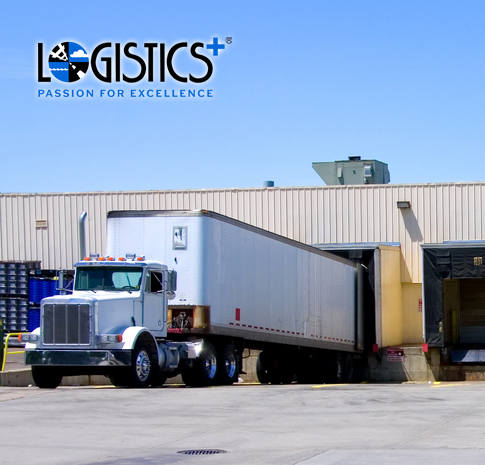
by logisticsplus | Oct 11, 2016 | News
 Less-than-truckload (LTL) shipping refers to relatively small freight deliveries that are too large to be classified as parcels and too small to fill an entire truck (i.e., full truckload). When obtaining LTL freight quotes for such shipments, carriers generally tend to consider anything between 150 and 5,000 pounds as a typical LTL shipment. Shipments over 5,000 pounds can also move via LTL carriers, but may require a spot or volume quote to obtain the best pricing. Because many LTL shipments move from small- and mid-sized businesses that lack sophisticated logistics or transportation departments and software, shippers are often not aware of how best to save time and money in this aspect of their business.
Less-than-truckload (LTL) shipping refers to relatively small freight deliveries that are too large to be classified as parcels and too small to fill an entire truck (i.e., full truckload). When obtaining LTL freight quotes for such shipments, carriers generally tend to consider anything between 150 and 5,000 pounds as a typical LTL shipment. Shipments over 5,000 pounds can also move via LTL carriers, but may require a spot or volume quote to obtain the best pricing. Because many LTL shipments move from small- and mid-sized businesses that lack sophisticated logistics or transportation departments and software, shippers are often not aware of how best to save time and money in this aspect of their business.
Logistics Plus recently participated in a good cover-story article titled “18 Sure-Fire ways to Save on LTL” that appeared in the September 2016 issue of Inbound Logistics magazine. Although we won’t list all 18 of those tips, here are a few noteworthy ones:
- Focus on the net cost. Discounts can be misleading. When shippers get a big discount from a carrier, they often think it’s a great deal; but there are so many other factors to consider, including the fact that “list price” base rates vary from carrier to carrier and from lane to lane. So an 80% discount off one carrier’s base rates may actually be more expensive than, say, a 75% discount from another base rate schedule. That’s why it is important to focus on only the total net cost, and not the discount (as we do here at Logistics Plus).
- Factor distance into the decision. Do you need a national or a regional LTL carrier? Some shippers will ship regional shipments with national carriers and, more often than not, pay a premium to do so. Similarly, some regional carriers will provide national service through “interline” partnerships with other carriers. Oftentimes these services will add additional days to the delivery of your shipment, and will require additional handling which increases chances for damages to occur. One of the benefits of working with Logistics Plus is that our eShipPlus transportation management system (TMS) will provide all of the national and regional carrier options best-suited for your shipment in one view.
- Consolidate orders. When Logistics Plus provides a free freight analysis for a client, we occasionally uncover multiple shipments to the same location on the same day. Consolidating these orders into one shipment will be more cost-effective for you, and probably more efficient for your customer to receive as well. Similarly, when companies ship LTL from multiple facilities or locations, there may be an opportunity to centralize the decision-making for that freight spend and leverage it for better freight discounts.
- Work with a 3PL. As noted above, an established and reputable 3PL can help you find the best rate, identify opportunities for more efficient shipping, audit and consolidate freight invoices, track and trace your critical shipments, and provide access to TMS technology.
If you’d like to work with Logistics Plus for any upcoming LTL freight quotes or services needs, simply click the button below to get started. Our 20-year LTL freight experts stand ready to help!

If you’d prefer to shop for your own carriers and rates, we can also provide you with complimentary access to eShipPlus.

by logisticsplus | Sep 27, 2016 | News
 U.S.-based less-than-truckload (LTL) carriers continue to announce their annual LTL general rate increases – or GRIs – earlier than in previous years. GRIs, which tend to be in the 4-6% range every year, are intended to offset carriers’ rising costs for new equipment, real estate, technology, and employee wages. Unfortunately, GRIs typically have the greatest impact on small- and medium-sized shippers who are not under contract with the carriers. The majority of LTL freight shipments that move under large-shipper contracts are usually not affected by general rate increases.
U.S.-based less-than-truckload (LTL) carriers continue to announce their annual LTL general rate increases – or GRIs – earlier than in previous years. GRIs, which tend to be in the 4-6% range every year, are intended to offset carriers’ rising costs for new equipment, real estate, technology, and employee wages. Unfortunately, GRIs typically have the greatest impact on small- and medium-sized shippers who are not under contract with the carriers. The majority of LTL freight shipments that move under large-shipper contracts are usually not affected by general rate increases.
So far, here are the LTL carriers that have announced fall rate hikes:
- ABF Freight – 5.2% effective 8/29/16
- YRC Freight – 4.9% effective 9/5/16
- UPS Freight – 4.9% effective 9/19/16
- Old Dominion – 4.9% effective 9/26/16
- Roadrunner – 4.9% effective 9/26/16
- XPO Logistics (Con-way) – 4.9% effective 9/26/16
- Estes Express – 4.9% effective 10/17/16
- FedEx Freight – 4.9% effective 1/2/17
Most of the other LTL carriers implement similar GRIs without publicly announcing them. With the majority of LTL business moving among the top 25 carriers, pricing discipline in the industry remains strong despite sluggishness in the overall economy.
So how can small- and medium-sized shippers insulate themselves from these significant increases?
One sure-fire method is to work with a third-party logistics company that has pre-negotiated contracts with all of the carriers that fall outside the scope of their standard GRIs. At Logistics Plus, we have agreements in place with almost all of the major LTL carriers that operate outside the influence of their standard, annual rate hikes. We do review these contracts periodically and, when warranted, allow our LTL carrier partners to increase rates slightly to offset their increases in costs. However, such increases are almost always well below the GRIs imposed on the broader shipping community.
So if you’re looking to mitigate annual LTL carrier GRIs and create greater pricing predictability for your freight transportation spend, click the button below to get started with Logistics Plus. Let us worry about LTL carrier rates and negotiations so that you can focus on growing your business.




 Parcel Shipping: Shipments under 150 pounds and shipped in cartons (less than 108 inches long and 67 inches wide), rather than on a pallet, are often moved via Parcel shipping with carriers such as USPS, UPS, FedEx or regional courier services.
Parcel Shipping: Shipments under 150 pounds and shipped in cartons (less than 108 inches long and 67 inches wide), rather than on a pallet, are often moved via Parcel shipping with carriers such as USPS, UPS, FedEx or regional courier services.
 Volume Less-Than-Truckload (LTL) Shipping: Shipments between 5,000 and 10,000 pounds, or taking up more than 6 pallet spaces, are often moved more cost-effectively with a “volume” or “spot” quote. In these situations, the carrier will analyze the weight and dimensions of the shipment and provide a competitive “all-in” rate quote.
Volume Less-Than-Truckload (LTL) Shipping: Shipments between 5,000 and 10,000 pounds, or taking up more than 6 pallet spaces, are often moved more cost-effectively with a “volume” or “spot” quote. In these situations, the carrier will analyze the weight and dimensions of the shipment and provide a competitive “all-in” rate quote.
 Partial Truckload Shipping: Shipments between 10,000 and 20,000 pounds, or taking up more than 10 pallet spaces, are often moved more cost-effectively as a partial truckload. In these situations, the truckload carrier will analyze the weight and dimensions of the shipment and provide a competitive “all-in” rate quote.
Partial Truckload Shipping: Shipments between 10,000 and 20,000 pounds, or taking up more than 10 pallet spaces, are often moved more cost-effectively as a partial truckload. In these situations, the truckload carrier will analyze the weight and dimensions of the shipment and provide a competitive “all-in” rate quote.
 Full Truckload (FTL) Shipping: Shipments over 20,000 pounds are often moved more cost-effectively as a full truckload. In these situations, the carrier will analyze the weight and dimensions of the shipment and provide a competitive “all-in” rate quote.
Full Truckload (FTL) Shipping: Shipments over 20,000 pounds are often moved more cost-effectively as a full truckload. In these situations, the carrier will analyze the weight and dimensions of the shipment and provide a competitive “all-in” rate quote.



 The leaves are turning, temperatures are dropping, and the peak Fall freight shipping season is here once again. Manufacturers are working to ship year-end orders, distributors are managing inventory and fulfilling shipments, and retailers are stocking shelves for the holidays. No matter where your business lies within the supply chain, finding affordable and reliable freight capacity this time of year is critical. To help get you through the season, here are 8 cost-saving freight shipping tips for you to consider:
The leaves are turning, temperatures are dropping, and the peak Fall freight shipping season is here once again. Manufacturers are working to ship year-end orders, distributors are managing inventory and fulfilling shipments, and retailers are stocking shelves for the holidays. No matter where your business lies within the supply chain, finding affordable and reliable freight capacity this time of year is critical. To help get you through the season, here are 8 cost-saving freight shipping tips for you to consider:




